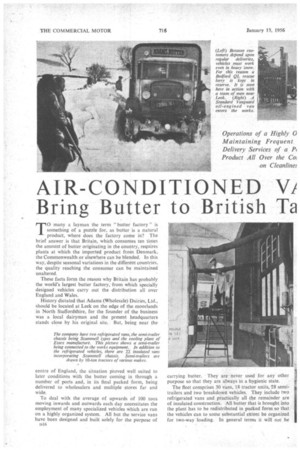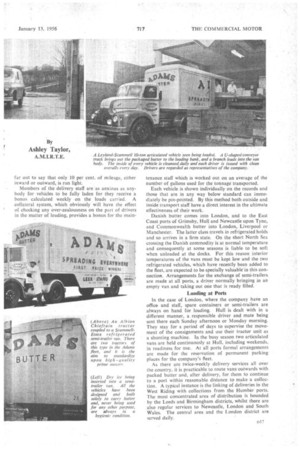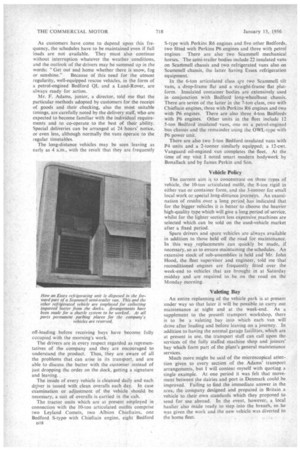AIR-CONDITIONED V) Bring Butter to British Ta
Page 62

Page 63

Page 64

If you've noticed an error in this article please click here to report it so we can fix it.
By
Ashley Taylor,
A.M.I.R.T.E.
TO many a layman the term "butter factory" is something of a puzzle for, as butter is a natural product, where does the factory come in? The brief answer is that Britain, which consumes ten times the amount of butter originating in the country, requires plants at which the imported product from Denmark. the Commonwealth or elsewhere can be blended. In this way, despite seasonal variations in the different countries, the quality reaching the consumer can be maintained unaltered.
These facts form the reason why Britain has probably the world's largest butter factory, from which specially designed vehicles carry out the distribution all over England and Wales.
History dictated that Adams (Wholesale) Dairies, Ltd., shouki be located at Leek on the edge of the moorlands in North Staffordshire, for the founder of the business was a local dairyman and the present headquarters stands close by his original site. But, being near the centre of England, the situation proved well suited to later conditions with the butter corning in through a number of ports and, in its final packed form, being delivered to wholesalers and multiple stores far and wide.
To deal with the average of upwards of 100 tons moving inwards and outwards each day necessitates the employment of many specialized vehicles which are run on a highly organized system. All but the service vans have been designed and built solely for the purpose of D16 carrying butter. They are never used for any other purpose so that they are always in a hygienic state.
The fleet comprises 30 vans, 18 tractor units, 28 semitrailers and two breakdown vehicles. They include two refrigerated vans and practically all the remainder are of insulated construction. All butter that is brought into the plant has to be redistributed in packed form so that the vehicles can to some substantial extent be organized for two-way loading. In general terms it will not be
far out to say that only 10 per cent. of mileage, either inward or outward, is run light.
Members of the delivery staff are as anxious as anybody for vehicles to be fully laden for they receive a bonus calculated weekly on the loads carried. A collateral system, which obviously will have the effect of checking any over-zealousness on the part of drivers in the matter of loading, provides a bonus for the main tenance staff which is worked out on an average of the number of gallons used for the tonnage transported.
Each vehicle is shown individually on the records and those that are in any way below standard can immediately be pin-pointed. By this method both outside and inside transport staff have a direct interest in the ultimate effectiveness of their work.
Danish butter comes into London, and to the East Coast ports of Grimsby, Hull and Newcastle upon Tyne, and Commonwealth butter into London, Liverpool or Manchester, The latter class travels in refrigerated holds and so arrives in a firm state. On the short North Sea crossing the Danish commodity is at normal temperature and consequently at some seasons is liable to be soft when unloaded at the docks. For this reason interior temperatures of the vans must be kept low and the two refrigerated vehicles, which have recently been added to the fleet, are expected to be specially valuablein this connection. Arrangements for the exchange of semi-trailers are made at all ports, a driver normally bringing in an empty van and taking out one that is ready filled.
Loading at Ports
In the case of London, where the company have an office and staff, spare containers or semi-trailers are always on hand for loading. Hull is dealt with in a different manner, a responsible driver and mate being sent there each Sunday afternoon or Monday morning. They stay for a period of days to supervise the movement of the consignments and use their tractor unit as a shunting machine. In the busy season two articulated vans are held continuously at Hull, including weekends, in readiness for use. At all ports formal arrangements are made for the reservation of permanent parking places for the company's fleet.
As there are twice-weekly delivery services all over the country, it is practicable to route vans outwardswith packed butter and, after delivery, for them to continue to a port within reasonable distance to make a collection. A typical instance is the linking of deliveries in the West Riding with collections from the Humber ports. The most concentrated area of distribution is bounded by the Leeds and Birmingham districts, whilst there are also regular services to Newcastle, London and South Wales. The central area and the London district are served daily.
As customers have come to depend upon this frequency, the schedules have to be maintained even if full loads are not available. They must also continue without interruption whatever the weather conditions, and the outlook of the drivers may be summed up in the words: "Get out and home whether there is snow, fog or sunshine." Because of this need for the utmost regularity, well-equipped rescue vehicles, in the form of a petrol-engined Bedford QL and a Land-Rover, are always ready for action.
Mr. F. Adams, junior, a director, told me that the particular methods adopted by customers for the receipt of goods and their checking, also the most suitable timings, are carefully noted by the delivery staff, who are expected to become familiar with the individual requirements and to co-operate to the best of their ability. Special deliveries can be arranged at 24 hours notice, or even less, although normally the vans operate to the regular timetables.
The long-distance vehicles may be seen leaving as early as 4 a.m., with the result that they arc frequently
off-loading before receiving bays have become fully cccupied with the morning's work.
The drivers are in every respect regarded as representatives of the company and they are encouraged to understand the product. Thus, they are aware of all the problems that can arise in its transport, and are able to discuss the butter with the customer instead of just dropping the order on the dock, getting a signature and leaving.
The inside of every vehicle is cleansed daily and each driver is issued with dean overalls each day. In case examination or adjustment of the vehicle should be necessary, a suit of overalls is carried in the cab.
The tractor units which are at present employed in connection with the 10-ton articulated outfits comprise two Leyland Comets, two Albion Chieftains, one Bedford S-type with Chieftain engine, eight Bedford 1318 S-type with Perkins R6 engines and five other Bedfords, two fitted with Perkins P6 engines and three with petrol engines There are also two Scammell mechanical horses. The semi-trailer bodies include 22 insulated vans on Scariunell chassis and two refrigerated vans also on Scammell chassis, the latter having Essex refrigeration equipment.
In the 6-ton articulated class are two Scammell tilt vans, a drop-frame flat and. a straight-frame flat platform. Insulated container bodies are extensively used in conjunction with Bedford long-wheelbase chassis. There are seven of the latter in the 7-ton class, two with Chieftain engines, three with Perkins R6 engines and two with P6 engines. There are also three 4-ton Bedfords with P6 engines. Other units in the fleet include 12 5-ton Bedford insulated vans, one on a petrol-engined bus chassis and the remainder using the OWL-type with P6 power unit.
There are also two 3-ton Bedford insulated vans with P4 units and a 2-tonner similarly equipped; a 12-cwt. Vanguard oil-engined van completes the fleet. At the time of my visit I noted smart modern bodywork by Bonallack and by James Perkin and Son.
Vehicle Policy
The. current aim is to concentrate on three :types of vehicle, the 10-ton articulated outfit, the 8-ton rigid in either van or container form, and the 3-tormer for small local work or.speeial long-distance journeys. An examination of results over a long period, has indicated that for the bigger vehicles it is better to choose the heavier high-quality type which will give a long period of service, whilst for the lighter section less expensive machines are selected which can be sold on the used-vehicle market after a fixed period.
Spare drivers and spare vehicles are always available in addition to those held off the road for maintenance. In this way _replacements can quickly be made, if necessary, so as to ensure maintaining the schedules. An extensive stock of sub-assemblies is held and Mr. John Hood, the fleet supervisor and engineer, told me that reconditioned engines are frequently fitted over the week-end to vehicles that are brought in at Saturday midday and are required to be on the road on the Monday morning.
Valethig Bay
An entire replanning of the vehicle park is at present under way so that later it will be possible to carry out maintenance at night and at the week-end. As a supplement to the preserit transport workshop, there is to be a valeting bay into which each van will drive after loading and before leaving on a journey. In addition to having the normal garage facilities, which are at present in use, the transport staff can call upon the services of the fully staffed machine shop and joiners' bay which form part of the plant's general maintenance services.
Much more might be said of the microscopical attention given to every section of the Adams' transport arrangements, but I will content myself with quoting a single example. At one period it was felt that movement between the dairies and port in Denmark could he improved. Failing to find the immediate answer in the area, the company designed and prepared in Britain a vehicle to their own standards which they proposed to send for use abroad. In the event, however, a local haulier also made ready to step into the breach, so he was given the work and the new vehicle was diverted to the home fleet.




























































































































